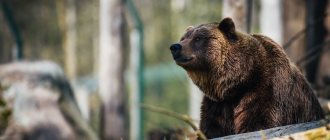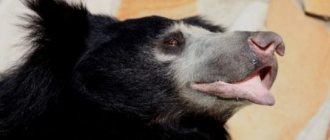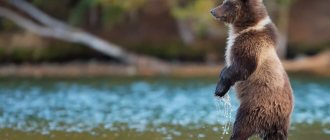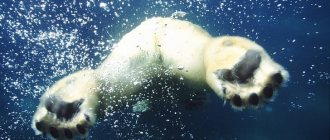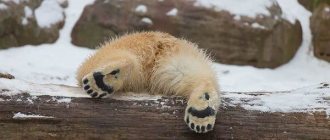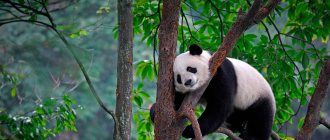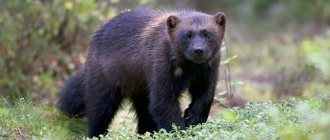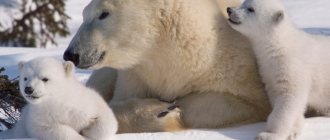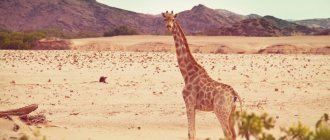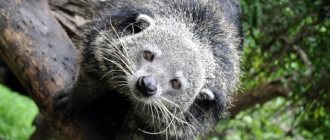- Wild animals
- >>
- Mammals
The spectacled bear is a native South American inhabitant.
He can be called the only representative of the bear kingdom who settled in South America. In fact, this bear is not too big and has an interesting and unique coloring of its face, which is why it was nicknamed “spectacled”. It's sad, but these days these bears are considered very rare, because there are very few of them left. Let's try to find out why there is such a deplorable situation with the numbers of this interesting bear and study its vital activity.
Origin of the species and description
Photo: Spectacled bear
The spectacled bear belongs to predators from the bear family. He is the only one of his kind from the subfamily of short-faced bears that has survived to this day. Zoologists believe that he owes this to his ability to climb tall trees growing in the forests of the Andes.
Scientists consider the closest prehistoric relative of the spectacled bear to be the giant short-faced bear, which lived during the Ice Age and became extinct approximately 12,000 years ago. The discovered remains of this giant indicate that the weight of the animal reached up to a ton, and the height of the bear when standing reached almost four meters.
Video: Spectacled bear
Of course, the spectacled bear is several times smaller than its ancestor, its weight varies from 80 to 130 kg. Although there is one very interesting specimen living in the Argentine zoo in the city of Buenos Aires. As noted in 2014, this bear gained a mass of 575 kg, truly a real giant. A fossil species close to the modern spectacled bear was found in North America; it is called the Florida cave bear. Another close relative of the Andean bear is the giant panda.
An interesting characteristic feature of the spectacled bear is not only the presence of contrasting fur glasses framing the eyes, but also a shorter muzzle compared to other members of the bear community. That is why this bear is called spectacled and belongs to the short-faced subfamily.
If we talk about the species of spectacled bear, then little is known about it. Scientists have only noticed that individuals living in the northern regions of their range are slightly larger than those living to the south; no other significant distinguishing features were noticed between Andean bears living in different territories.
Kodiak (weight 800 – 1000 kg)
The largest brown bear in the world, the Kodiak, is in an honorable second place in the ranking. The weight of the animal reaches one ton, the size of the body is 2 m 80 cm. Its body is knitted, sinewy, with a large head. The coat color ranges from dark brown to black. Habitat: Alaska (Kodiak archipelago). The Kodiak is omnivorous - it digs up roots, collects berries and herbs, catches salmon during spawning, and does not disdain carrion. Prefers a solitary lifestyle. The mammal is under state protection; only 160 animals are allowed to be shot per year. Today their number does not exceed 3 thousand.
Appearance and features
Photo: Animal spectacled bear
We figured out the weight of the bear earlier, but the length of its body can be from one and a half meters to 180 cm, not counting the tail, the length of which does not exceed 10 cm. The height of the bear at the withers is from 60 to 90 cm. Females are much smaller than males and weigh less . The bear's head is neat but powerful, the muzzle is slightly shortened, and has a light-colored mask that resembles glasses. The predator's ears are small and round, and its eyes are also small.
Apart from the interesting light colors on the face and neck, the rest of the color of the spectacled bear's fur coat is monochromatic, it can be:
- Rich black;
- Black-brown;
- Brownish red.
In general, the fur coat of the Andean bear is quite thick, shaggy, long, and shimmers beautifully in the sun’s rays. The spectacled bear itself is strong and powerful, it has a muscular short neck, its limbs are not too long, but strong and squat. The spectacled bear walks, stepping on its heels. The front legs are much longer than the hind legs, so the bear is an excellent climber not only in trees, but also on rocks.
An interesting feature of the skeletal structure of the spectacled bear is that it has thirteen pairs of ribs, while other bears have fourteen pairs. Speaking about the light beige or slightly yellowish pattern on the face and neck of the bear, it is worth noting that in some individuals this pattern is partially absent, and in some specimens it is not observed at all, i.e. The bear has a completely monochromatic color.
Life cycle
The cubs are born with their eyes closed and weigh about 300 grams. The eyes open at the end of the first month of life. The cubs are black in color and even display distinctive white or yellow markings. Babies grow quite quickly and after 180 days they weigh an average of 10 kilograms. For at least one year after birth, the female does not let go of her offspring. Life expectancy is a little over 20 years.
This is interesting: Commercial fish species: names, photos and characteristics
Where does the spectacled bear live?
Photo: Spectacled bear from South America
There is only one bear on the South American continent - the spectacled one.
It can be seen in various states of this continent:
- In the east of Panama;
- In western Colombia;
- In Venezuela;
- Peru;
- Ecuador;
- Bolivia;
- Argentina (in the north-west of the country).
The spectacled bear has chosen mountain forests located on the western Andean slopes. The bear feels great at an altitude of more than three kilometers, because it moves well along steep rocks, having tenacious and strong forelimbs. It is wrong to think that a bear has a permanent residence only in mountainous areas; it can also live in open spaces of meadows, savannas, the predator also lives in dense growth of all kinds of bushes.
Bears have been seen living on the plains, where the vegetation is sparse and not very diverse; there are individuals living in swampy areas. The main condition for choosing a permanent place of residence for bears is not the landscape and climate, but the availability of food and its availability in a particular place.
Still, it is worth noting that the spectacled bear gives its preference to mountain forests with high humidity, avoiding arid forest areas. The bear tries to stay near various water sources. The habitat of spectacled predators stretches more than 4.5 km in length and only from 200 to 650 km in width. It starts from the Sierra de Perija range located in the north and reaches the eastern part of the Cordillera, which is in the south of Bolivia. Previously, the habitat of these bears was wider and extended to other areas of the Andes.
Range, habitats
The habitat of spectacled bears is represented by the western part and southern regions of the South American continent, including eastern Panama, western Colombia, Venezuela, Peru and Ecuador. In addition, such a predatory mammal is found in Bolivia and in the northwestern part of Argentina.
Today, the spectacled bear is the only representative of the bear family living in South America. The beast prefers mountain forests on the western slope of the Andes, located at an altitude of no more than three thousand meters above sea level. However, such a predator may well appear on open meadow slopes, in low-lying savannas and bush thickets.
What does the Andean bear eat?
Photo: Spectacled bear Red Book
The spectacled bear takes an honorable second place in eating plant foods. In the first place of the pedestal is a giant panda. This is strange for a predator, but this bear's menu is 95 percent plant-based and only the remaining five percent is animal food.
For most predators, plant foods are very heavy on their stomach, which complicates the digestion process, but spectacled bears are in complete order. Their diet for the most part consists of all kinds of fruits, foliage, rhizomes and tubers, young shoots of various plants. Bears can climb tall palm trees, break off their powerful branches and eat foliage already on the ground. They are not afraid to climb even large cactus plants to pick their fleshy fruits.
These animals can even eat very hard tree bark, because they have a powerful and strong jaw apparatus in their arsenal. In some areas, bears greatly destroy fields of corn, which they love to eat. In addition to corn, sugar cane and wild bee honey are delicacies for them, because by nature they have a great sweet tooth.
If we talk about the bear's menu of animal origin, it includes: various rodents, small deer, vicuñas, guanacos, hares, some birds and even arthropods. The bear is not averse to eating bird eggs, so he is not at all alien to the destruction of their nests.
It is interesting that the spectacled bear has a very long tongue, which it uses to eat termites and ants, barbarically destroying their homes. In difficult times, when it is not easy to find food, animals can raid livestock pastures, but such cases are extremely rare; in times of hunger, spectacled bears prefer to be content with carrion left over from the meals of other predators. This is a rather interesting and unusual diet for these bear representatives.
Basic diet
Despite the fact that bears are considered omnivores, 95% of their diet comes from plant foods and only 5% from animals. They eat various fruits, berries, young shoots, rhizomes and cannot resist cacti. Just like all bears, the spectacled one is famous for its love of honey: in search of its favorite treat, the animal destroys hives and extracts wild honey. If there is a shortage of plant food, the bear can hunt rabbits, rodents, birds, and also destroy bird nests.
Features of character and lifestyle
Photo: Spectacled bear animal
Spectacled bears prefer a solitary existence, acquiring a pair only during the mating season. Although sometimes in places of great abundance of various foods several bears can coexist in the same territory. However, usually predators each live in their own area, which they carefully mark. The spectacled bear is quite good-natured and will not attack or incite conflict over trifles. Even if someone stranger came to his territory, he would limit himself to only a growling warning to see off the uninvited guest.
These bears attack only in extreme cases, when there is no other choice. They usually avoid unwanted encounters (for example, with a person) by climbing tall trees. There, high in the crown (about 30 meters in height), bears build themselves something like a platform, where they rest and store their food supplies. Mother bears can be aggressive and are ready to do anything to protect their clumsy offspring.
It is interesting that these bears are active and energetic during daylight hours, which is not typical for predators. They usually hunt and get food in the morning and late afternoon. Winter hibernation is not typical for this type of bear, and they rarely make dens. Sometimes in dense bushes they make something similar to a nest, which they skillfully camouflage, so it is not easy to notice.
If there is enough food in the bear's territory, then the spectacled predator does not move further than half a kilometer from its nest. During periods of hunger, bears can travel about six kilometers in a day in search of food. In communication between bear relatives, smells play a large role, and sounds fade into the background. Most often, only the mother bear communicates with the cubs using some sound signals.
So, the spectacled bear is a fairly peaceful animal, not aggressive and not prone to conflicts. The predator's disposition is quiet and calm; the bear avoids people, choosing remote and secluded areas for its life.
Social structure and reproduction
Photo: Spectacled bear cub
As it has already turned out, spectacled bears live alone, but sometimes several individuals can coexist peacefully in one territory rich in food. Females become sexually mature by the age of three, and males by the age of six. The mating season, during which animals form pairs, lasts from early spring to mid-autumn. The union of two animals of different sexes lasts only a few weeks, then the partners separate forever.
The period of gestation of cubs in spectacled bears is very long, it lasts for 8 months. This happens because pregnancy has a latency period necessary for the cubs to be born at a time when there is enough food. There are from one to three cubs in a litter. They are born with black fur, but are completely blind and weigh only about 300 grams. Closer to the age of one month, babies begin to see clearly and at the same time begin to leave their shelter. Bear cubs grow very quickly, and at the age of six months their weight already reaches 10 kg.
The cubs accompany their caring mother everywhere, who instills in them all the skills necessary for life: teaches them to hunt, find tasty and healthy plant food, and properly plan their diet. The mother protects her grown-up offspring for a long time, who usually live with her for up to two years, and then go in search of their own territory, where they continue their independent existence. In the wild, the lifespan of a spectacled bear is a quarter of a century, and in captivity there were specimens that lived up to 36 years.
You should know it
- International scientific name: Tremarctos ornatus.
- Conservation status: vulnerable species.
- Characteristics: male body length - 1.2-1.8 m, weight - from 100 to 175 kg; females are 30-50% smaller than males. The coat is long, black, sometimes with a brown tint.
- This is interesting: in captivity, a spectacled bear can live up to 38 years; life expectancy in the wild is much shorter, approximately 25 years.
Natural enemies of spectacled bears
Photo: Spectacled bear South America
In wild, natural conditions, newly born cubs and inexperienced young animals are most at risk. They are threatened by large predators such as pumas and jaguars, and male spectacled bears, which often attack weak cubs, are also dangerous to bear cubs.
As sad as it is to realize, the most dangerous and ruthless enemy of the spectacled bear is man, due to whose activities the population of these unusual animals is on the verge of complete extinction, and once these predators were widespread. People exterminated a huge number of bears due to the fact that they attacked livestock and ravaged corn fields. In Peru, the meat of this predator has always been eaten. Not only the skin of the bear is highly valued, but also its fat and internal organs, which are used in medicine.
In addition to the fact that man deliberately killed spectacled bears, he also destroyed them indirectly, occupying their permanent habitats for his own needs, cutting down forests, and building highways. All this led to the fact that the bear almost disappeared completely. Now this species is listed in the Red Book, hunting for it is strictly prohibited, but poaching still occurs. Now the number of these predators is quite stable, but very few in number, so the species is considered endangered.
Grizzly bear (weight up to 450 kg)
The grizzly bear is a ferocious and ruthless predator. Outwardly, it is very similar to a brown bear (they belong to the same subspecies). But the grizzly is a more powerful and powerful mammal. Its weight is 450 kg, height is about 2 m 50 cm. Habitat: Alaska, Canada, USA. Main food: salmon, rodents, fruits, honey. Capable of killing an elk if desired. But it attacks a person only in a state of severe hunger or irritation. By the way, the grizzly bear ranks 7th in the ranking of the most dangerous animals in the world.
Population and species status
Photo: Spectacled bear
The population of spectacled bears has declined catastrophically due to the actions of people who sometimes think only about their own benefits, forgetting that they can harm their smaller brothers. Active and vigorous human activity, including plowing land, laying roads, building various structures, extracting minerals, clearing land for pastures, has led to the fact that there are fewer and fewer untouched territories where the spectacled bear could live freely.
The hunting of the Andean bear, which until recently was very active, has led to the fact that these funny and unusual predators are practically gone. People use not only meat and bear skin, but fat, internal organs and bile of bears. Bear fat is used in the treatment of diseases such as rheumatism and arthritis, and the gallbladder is constantly used in Chinese medicine.
According to official data, zoological scientists have established that the current population of spectacled bears numbers from 2 to 2.4 thousand animals, which are protected by law. There is now stability in the population size. No sharp or significant increases have been observed, despite all the measures taken, but no strong declines have been noticed recently either.
Notes
- Sokolov V. E.
Five-language dictionary of animal names. Mammals. Latin, Russian, English, German, French. / under the general editorship of academician. V. E. Sokolova. - M.: Rus. lang., 1984. - P. 96. - 10,000 copies.
| : Incorrect or missing image | To improve this article it is desirable:
|
| South America Biology |
